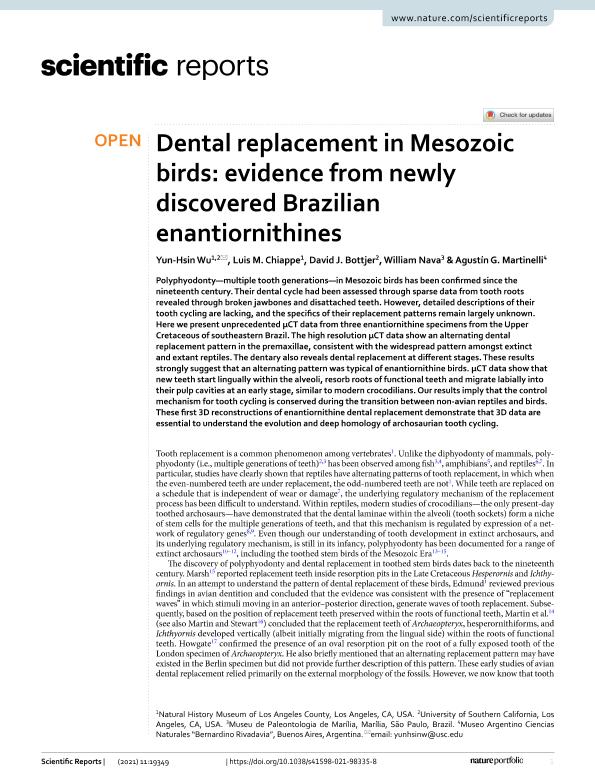Artículo
Dental replacement in Mesozoic birds: evidence from newly discovered Brazilian enantiornithines
Fecha de publicación:
09/2021
Editorial:
Nature
Revista:
Scientific Reports
ISSN:
2045-2322
Idioma:
Inglés
Tipo de recurso:
Artículo publicado
Clasificación temática:
Resumen
Polyphyodonty—multiple tooth generations—in Mesozoic birds has been confirmed since the nineteenth century. Their dental cycle had been assessed through sparse data from tooth roots revealed through broken jawbones and disattached teeth. However, detailed descriptions of their tooth cycling are lacking, and the specifics of their replacement patterns remain largely unknown. Here we present unprecedented µCT data from three enantiornithine specimens from the Upper Cretaceous of southeastern Brazil. The high resolution µCT data show an alternating dental replacement pattern in the premaxillae, consistent with the widespread pattern amongst extinct and extant reptiles. The dentary also reveals dental replacement at different stages. These results strongly suggest that an alternating pattern was typical of enantiornithine birds. µCT data show that new teeth start lingually within the alveoli, resorb roots of functional teeth and migrate labially into their pulp cavities at an early stage, similar to modern crocodilians. Our results imply that the control mechanism for tooth cycling is conserved during the transition between non-avian reptiles and birds. These first 3D reconstructions of enantiornithine dental replacement demonstrate that 3D data are essential to understand the evolution and deep homology of archosaurian tooth cycling.
Palabras clave:
CRETACICO
,
TOOTH REPLACEMENT
,
AVES
,
ENANTIORNITHINES
Archivos asociados
Licencia
Identificadores
Colecciones
Articulos(MACNBR)
Articulos de MUSEO ARG.DE CS.NAT "BERNARDINO RIVADAVIA"
Articulos de MUSEO ARG.DE CS.NAT "BERNARDINO RIVADAVIA"
Citación
Wu, Yun Hsin; Chiappe, Luis M.; Bottjer, David J.; Nava, William; Martinelli, Agustín Guillermo; Dental replacement in Mesozoic birds: evidence from newly discovered Brazilian enantiornithines; Nature; Scientific Reports; 11; 1; 9-2021; 1-12
Compartir
Altmétricas




